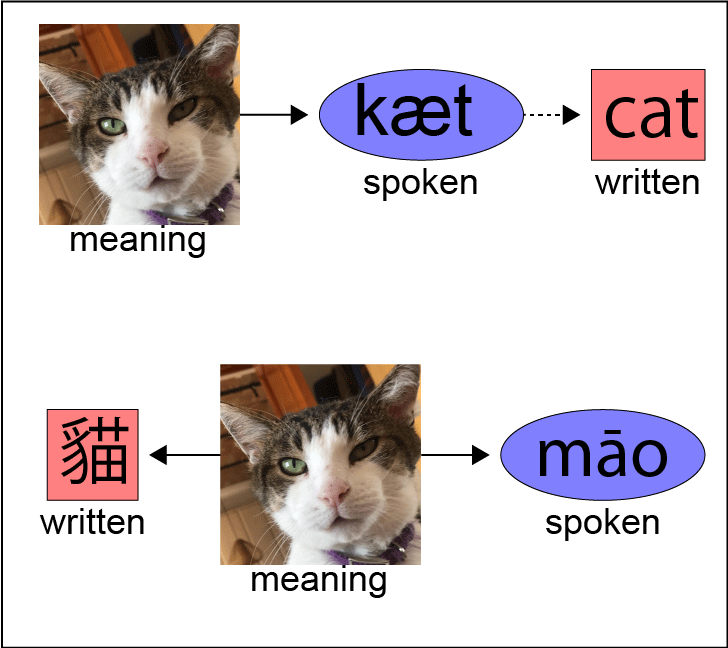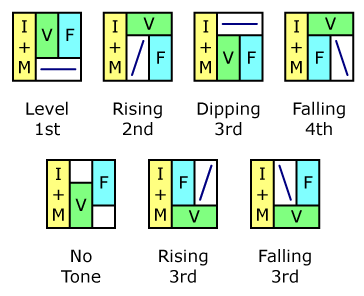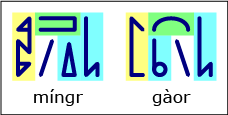 Musa for Chinese
Musa for Chinese
Chinese characters are a very old writing system. Along with the even older Ancient Egyptian hieroglyphs, it is the only writing system among the world's 50 or so, past and present, to represent meaning directly - all the others represent sound, so that you have to know the language to be able to read. That's not true in Chinese; in fact, the same character can be read in many different ways among the numerous languages that use characters and even within a single language. Most characters include an element that represents a partial or former pronunciation, but it doesn't indicate the current pronunciation.
The problem with this approach is very simple: there is no relationship between the written and spoken forms of words, so they have to be learned separately. If a language has good phonetic orthography - a good alphabet and good spelling, like Musa offers - then the relationship between the spoken and written language (the dotted line below) is very simple, and learning to read and write is easy.
"
In the case of Chinese, the relationship between meaning and the written character has become completely arbitrary, as explained on this page. The character for cat uses the radical for badger, which is at least a small animal. But the rest of the character spells seedling, nothing to do with cats! It's there hinting at the pronunciation, since the word for seedling is miáo. So even the scholars who wrote Classical Chinese were trying to spell pronunciation - they just didn't have an alphabet.
The Chinese believe that characters have important advantages over alphabets: that they're easier to read or easier to understand, but those claims are dubious. The same text in characters is normally about as long - and takes about as long to read - as its alphabetic translation.
But characters are definitely much, much harder to learn, and to remember! If you know Chinese, here's a short exercise that will remind you of that. Just write down, on a piece of paper, the characters for the three words below (a thumb, a sneeze, and toothpaste) and then compare what you wrote with the correct answers in the black boxes below.
 |
 |
 |
|---|
| 拇指 | 喷嚏 | 牙膏 |
|---|
Now write down the pinyin and compare it with the correct answers here:
| mǔzhǐ | pēntì | yágāo |
|---|
For most Chinese, remembering and writing the pinyin is much, much easier (and the Musa is even easier!). After all, you already know how to say the words. Characters are much harder to use. To address this issue, over the last century, the Chinese governments have simplified many characters, to mixed acclaim.
Another reform has been the introduction of an alphabet for auxiliary uses. The current system, called pinyin, is based on the Latin alphabet. It's used to indicate pronunciation, in dictionaries and in the classroom, and also used for text entry, sorting and lookup. In pinyin, every standard Chinese syllable has a unique spelling, although (like English!) it falls short of being a phonetic spelling.
Nor can pinyin be used to write the other Chinese languages like Wu (Shanghaiese), Min (Fukienese or Taiwanese), or Yue (Cantonese); the non-Chinese languages of China like Korean, Manchu, Mongolian, Uighur, Tibetan, Miao or Zhuang; or foreign names of people and places - it's used just for standard Chinese.
The rest of this page will describe the use of Musa to replace pinyin. For a discussion of why Musa might replace characters, please visit this page.
Pinyin
Pinyin, developed in the 1950s, is the latest and most successful in long series of romanizations, starting with the Wade-Giles system of 1892. It closely follows the Yale romanization of the 1940s, but adapted for native speakers, not Americans. It uses the English alphabet (with ü and without v) to write similar sounds of Chinese, but uses digraphs and odd readings for other Chinese sounds. For example, q represents a ch sound, while x represents a sh sound. The final -i represents three different sounds, while the finals -ian -iu -ui -un don't sound like they're spelled. Because of these difficulties, pinyin can't be read naturally by readers of any other Roman-alphabet language. But that's also true of English! For a deeper discussion of the problems of pinyin, please visit this page.
But the main problem of pinyin is not its unusual uses of Roman letters; it's its use of Roman letters! Spelling out pronunciation is a very important function - why should Chinese use an alphabet that is so poorly suited for it? Pinyin requires us to use digraphs like sh ch zh ng, unusual readings like x q c z, ambiguous letters like i, a dieresis over ü, capitalization, and other deficiencies ... to what end? To make Chinese legible to foreigners? To fit Chinese within the limitations of ASCII computers? They achieved neither; they deserve better.
In contrast, the Musa alphabet has letters for all the sounds of Chinese, including the tones: 22 consonants, 5 semivowels, 11 vowels, and 3 accents. And the same letters can be used to write Cantonese, Zhuang and even English! In Musa, Chinese is usually written in fangzi gait, which combines all the sounds of a syllable into one block, like Chinese characters. The arrangement of each block makes these characters easier to distinguish. The rest of this page will explain how it works.
Every Chinese syllable (except er) fits a neat formula: an initial consonant is followed by a medial semivowel, then a vowel, and finally a final: a consonant or off-glide. The whole syllable is also spoken with a tone, which we mark on the vowel. Some of these five elements may be missing or hidden in the written form.
Initials
In Chinese, there are 21 initials (声母 shēngmu). Here they are, shown with their pinyin romanizations, their Zhuyin (bopomofo) symbols, and their IPA transcriptions.
| | b | ㄅ | p | | d | ㄉ | t | | z | ㄗ | ʦ | | zh | ㄓ | tʂ | | j | ㄐ | ʨ | | g | ㄍ | k |
|---|---|---|---|---|---|---|---|---|---|---|---|---|---|---|---|---|---|---|---|---|---|---|---|
| | p | ㄆ | pʰ | | t | ㄊ | tʰ | | c | ㄘ | ʦʰ | | ch | ㄔ | tʂʰ | | q | ㄑ | ʨʰ | | k | ㄎ | kʰ |
| | f | ㄈ | f | | l | ㄌ | l | | s | ㄙ | s | | sh | ㄕ | ʂ | | x | ㄒ | ɕ | | h | ㄏ | x |
| | m | ㄇ | m | | n | ㄋ | n | | r | ㄖ | ʐ |
The sounds in pink are affricates and sibilants. The sounds in the fourth column (zh ch sh r) are retroflex (laminal post-alveolar), while the sounds in the fifth column (j q x) are (alveolo-)palatal. The letters in all three columns have U-shaped bottoms that kind of look like a tongue. This tongue points down for the alveolars, up for the retroflexes, and it's closed for the palatals.
It's also possible for a syllable to have no initial, in which case the medial is used as the initial.
Medials
The medials form a simple pattern: they are all formed high in the mouth - they're the consonant versions of closed vowels. Two are front semivowels, and two are back semivowels. One of each pair is pronounced with lips rounded; the other with lips spread.
| Semivowels | front | back | ||||||
|---|---|---|---|---|---|---|---|---|
| spread | | y | ㄧ | j | | ɰ | ||
| round | | ÿ | ㄩ | ɥ | | w | ㄨ | w |
The medial is only written when there's no initial: mɰa is written ma but ɰa is written with a visible . In Chinese, we don't omit other medials based on the preceding consonant - we write jian with a and juan with a - but we do omit them when followed by the matching vowel - we write jin and jun with no medials. Of course, if there's no initial, we write the medial: bwu is written bu, but wu is written wu.
Finals
Before considering the vowels, let's look at the finals. There are six of them:
| Finals | front | back | ||
|---|---|---|---|---|
| oral | | -i | | -u |
| nasal | | -n | | -ng |
| rhotic | | -r | | Break |
-
The -u final is sometimes written -o in pinyin.
The -r final is actually a contraction of another final plus the word 兒 ér (written 儿 in simplified form). This often entails a change in pronunciation, which we'll discuss below.
If there is no other final, we indicate the end of the syllable with a Break. So there is always a final, and no ambiguity about the break between syllables.
| | |
| 幾年 | 謹嚴 |
| jǐ-nyán | jǐn-yán |
| | |
Vowels
Now we're ready to consider the vowels. There are actually only three phonemic vowels: close, mid and open. What makes it interesting is that the vowel takes on the characteristics of the medial before it and the final after it, so that there are 12 phonetic vowels. We use round letters for the back vowels in Musa, even though they're not very round in Chinese. Here they are, with the mid vowels in pink:
| Vowels | front | central | back | pinyin | ||||
|---|---|---|---|---|---|---|---|---|
| close | spread | | i | | ɨ | i | ||
| round | | y | | u | ü u | |||
| mid-close | | e | | ɤ | | o | e o | |
| mid-open | | ɛ | | ə ʌ | e | |||
| open | | æ | | a | | ɑ | a | |
The high vowel always matches the medial, while the low vowel matches the final: front æ before front finals -i and -n, and back ɑ before back finals -u and -ng. The mid vowel is much more varied in its pronunciation. Here's a description of the variation, but you don't have to memorize it - just write each vowel as it's pronounced:
-
If there's no medial and no final or a -ng final, the mid vowel is pronounced as a back ɤ.
Between a back semivowel and -n, it becomes central ə.
After front y or ÿ with no final, it becomes front ɛ.
Before back -u or after back w with no final, it rises to back o.
Before front -i, it rises to front e.
Between front y and a nasal final, it closes to front i.
Between front ÿ and a nasal final, it closes to front y.
Between back w and back -ng, it closes to back u.
Syllables using the high central vowel are sometimes described as being syllabic consonants: the vowel is very reduced, and they never have a final. But we (and many others) consider them to have a very reduced ɨ vowel, an approach that fits well with the other vowels, with the pinyin spelling i, and with Musa in both Alphabet and Fangzi gait. There are only seven of them, shown here in first tone:
| | | | | | | |
| zi | ci | si | zhi | chi | shi | ri |
|---|
The combination of semivowel, vowel and final is called the rime (韻母 yùnmu). Here's a chart showing all the rimes of Chinese, in Musa, in pinyin, and in bopomofo:
| -i ㄭ | -e ㄜ | -ei ㄟ | -ou ㄡ | -en ㄣ | -eng ㄥ |
|---|---|---|---|---|---|
| -a ㄚ | -ai ㄞ | -ao ㄠ | -an ㄢ | -ang ㄤ | |
| -u ㄨ | -uo ㄨㄛ | -ui ㄨㄟ | -un ㄨㄣ | -ong ㄨㄥ | |
| -ua ㄨㄚ | -uai ㄨㄞ | -uan ㄨㄢ | -uang ㄨㄤ | ||
| -i ㄧ | -ie ㄧㄝ | -iu ㄧㄡ | -in ㄧㄣ | -ing ㄧㄥ | |
| -ia ㄧㄚ | -iao ㄧㄠ | -ian ㄧㄢ | -iang ㄧㄤ | ||
| -ü ㄩ | -üe ㄩㄝ | -ün ㄩㄣ | -iong ㄩㄥ | ||
| -üan ㄩㄢ |
Pinyin spelling has some variations that Musa doesn't need :
-
The rime -o (as in bo po mo fo) is spelled -o in Musa.
The rimes -ui -iu -un are spelled -uei -iou -uen in Musa.
The word weng is spelled wung in Musa.
The word me is spelled ma in Musa.
Rhotics
The only Chinese syllable that doesn't fit this pattern is er, as in the number two 二 èr, the word for ear 耳 ér, or the word for son, 兒 or 儿 ér. These words are always pronounced with a retroflex rhotic offglide, but it's sometimes preceded by an a or even an e, and sometimes not. In Musa, write it as you say it.
| |
| ér |
|---|
But this syllable is more commonly used as a suffix (usually written 儿), where it combines with the preceding syllable to produce a rhoticized final: the final becomes -r and the vowel also changes :
-
In most cases the low vowel is pronounced as back -ɑr
In most cases the mid vowel keeps its non-rhoticized pronunciation
Between a back semivowel and front oral -i, e is not so far forward: it's pronounced as central
-ər
The high vowels all become mid vowels
The -ng final is nasalized to -ɑ̃r or -ũr
| -ir ㄭㄦ | -er ㄜㄦ | -eir ㄟㄦ | -our ㄡㄦ | -enr ㄣㄦ | -engr ㄥㄦ |
|---|---|---|---|---|---|
| -ar ㄚㄦ | -air ㄞㄦ | -aor ㄠㄦ | -anr ㄢㄦ | -angr ㄤㄦ | |
| -ur ㄨㄦ | -uor ㄨㄛㄦ | -uir ㄨㄟㄦ | -unr ㄨㄣㄦ | -ongr ㄨㄥㄦ | |
| -uar ㄨㄚㄦ | -uair ㄨㄞㄦ | -uanr ㄨㄢㄦ | -uangr ㄨㄤㄦ | ||
| -ir ㄧㄦ | -ier ㄧㄝㄦ | -iur ㄧㄡㄦ | -inr ㄧㄣㄦ | -ingr ㄧㄥㄦ | |
| -iar ㄧㄚㄦ | -iaor ㄧㄠㄦ | -ianr ㄧㄢㄦ | -iangr ㄧㄤㄦ | ||
| -ür ㄩㄦ | -üer ㄩㄝㄦ | -ünr ㄩㄣㄦ | -iongr ㄩㄥㄦ | ||
| -üanr ㄩㄢㄦ |
Tones
Musa also marks the tone. The tones of Chinese are contour tones: it's the change in pitch that counts, not the pitch itself. The five tones are:
| | | | | |
|---|---|---|---|---|
| level | rising | dipping | falling | no tone |
| 1st | 2nd | 3rd | 4th | "5th" |
The first and third tones use the same accent mark, but it's written over the vowel in 3rd tone. Here are the five tones applied to the vowel a :
| | | | | |
|---|---|---|---|---|
| 1st | 2nd | 3rd | 4th | 5th |
The dipping (3rd) tone is pronounced differently and written differently when followed by another tone. If the following tone is another dipping tone, it's written as a low rising tone; otherwise, it's written as a low falling tone.
| | → | | | → | | |
| nǐ hǎo | ní hào | mǎi yú | mài yú |
|---|
Most dialects make very little auditory distinction between the normal rising (2nd) tone, and the low rising tone that results from a change to a dipping (3rd) tone, but Musa writes them differently.
The word 一 changes from level (1st) tone to rising (2nd) tone before a falling (4th) tone, and to falling (4th) tone before any other tone. The word 不 changes from falling (4th) tone to rising (2nd) tone before another falling (4th) tone.
Fangzi Gait
Chinese is normally written in fangzi gait, in which the elements are arranged to form a square character. The details of fangzi gait are explained on the Gaits page, but here's a summary of how it's used in Chinese.
Each syllable is written in a square that measures 3x3 "cells" the size of a Musa vowel. In this square are arranged the following elements :
-
The Initial consonant (marked as yellow "I" below), combined with any following Medial ("M") to form a ligature
The Tone (shown in white, or marked as red "T" below), which is stretched to be two cells wide or two cells tall
The Vowel (marked as green "V" below), also stretched to be two cells wide or two cells tall
The Final offglide or consonant (marked as blue "F" below)
The Initial + Medial ligature always fills the entire lefthand column, establishing a rhythm. If there's no initial, just the medial is written. If there's no other final, we write a Break, so that there is always a visible final. The position of the accent, vowel and final depend on the tone:

The elements are always written in the same order, no matter what their position within the character: initial+medial, then high vowel+tone or tone+low vowel, then the final. In other words, the stroke order is the same as the encoding order.
To write the four-letter rhotic rimes above - those in the fourth column with a w and those in the last column with a nasal - we write the second final in a fourth column to the right. Here's what that looks like:

Writing is horizontal, from left to right. Here are some examples:
Words
In classical Chinese, every character had its own meaning and its own one-syllable pronunciation: characters were "words". But in modern Chinese, most words are actually two syllables or more. Even when the individual characters carry the full meaning, they can no longer be understood in speech without each other. For example, the Chinese word for friend is 朋友 péngyǒu: each of the two characters means friend on its own, but they can't be understood in speech because of homophony, so the two are always combined, and in that same order.
Chinese characters are written without spaces, leaving it to the reader to break them up into words. But spaces are written in pinyin, and there are official rules about where to split words. We also separate words with spaces (sometimes with dots) when writing Chinese in Musa, using the same rules with a couple of exceptions. For example, reduplications like 尝试尝试 or 来来回回 don't need spaces or hyphens (Breaks) in Musa.
Transcriber
The transcriber is a tool for converting Chinese from characters or pinyin to Musa:
Sample
Putting it all together, why don't you try reading a sentence or two?
| |
| 三十六计,走为上计。 |
| |
| 路遥知马力,日久见人心。 |
Finally, here is an excerpt from Diary of a Madman 狂人日记, the famous story by Lu Xun 鲁迅:
|
|
| 凡事总须研究,才会明白。古来时常吃人,我也还记得,可是不甚清楚。我翻开历史一查,这历史没有年代,歪歪斜斜的每叶上都写着“仁义道德”几个字。我横竖睡不着,仔细看了半夜,才从字缝里看出字来,满本都写着两个字是“吃人”! |
| © 2002-2025 The Musa Academy | musa@musa.bet | 21apr25 |
